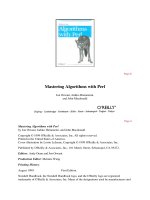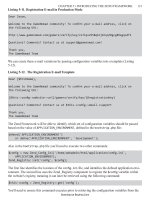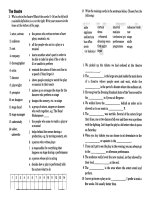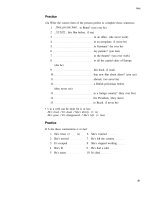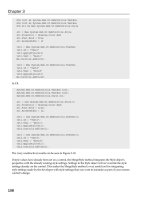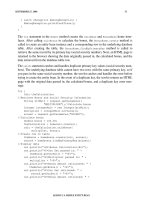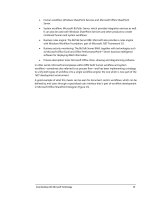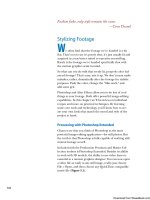Mastering Algorithms with Perl phần 4 ppt
Bạn đang xem bản rút gọn của tài liệu. Xem và tải ngay bản đầy đủ của tài liệu tại đây (1.32 MB, 74 trang )
while loop. If you don't mind explicit loop controls such as next, use this alternate
implementation for intersection. It's about 10% faster with our test input.break
sub intersection {
my ( $i, $sizei ) = ( 0, scalar keys %{ $_[0] } );
my ( $j, $sizej );
# Find the smallest hash to start.
for ( $j = 1; $j < @_; $j++ ) {
$sizej = scalar keys %{ $_[ $j ] };
( $i, $sizei ) = ( $j, $sizej )
if $sizej < $sizei;
}
my ( $possible, %intersection );
TRYELEM:
# Check each possible member against all the remaining sets.
foreach $possible ( keys %{ splice @_, $i, 1 } ) {
foreach ( @_ ) {
next TRYELEM unless exists $_->{ $possible };
}
$intersection{$possible} = undef;
}
Page 215
return \%intersection;
}
Here is the union written in traditional procedural programming style (explicitly loop over the
parameters):
sub union {
my %union = ( );
while ( @_ ) {
# Just keep accumulating the keys, slice by slice.
@union{ keys %{ $_[0] } } = ( );
shift;
}
return \%union;
}
or, for those who like their code more in the functional programming style (or, more terse):
sub union { return { map { %$_ } @_ } }
or even:
sub union { +{ map { %$_ } @_ } }
The + acts here as a disambiguator: it forces the { . . . } to be understood as an
anonymous hash reference instead of a block.
We initialize the values to undef instead of 1 for two reasons:
• Some day we might want to store something more than just a Boolean value in the hash. That
day is in fact quite soon; see the section ''Sets of Sets" later in this chapter.
• Initializing to anything but undef, such as with ones, @hash{ @keys } = (1) x
@keys is much slower because the list full of ones on the righthand side has to be generated.
There is only one undef in Perl, but the ones would be all saved as individual copies. Using
just the one undef saves space.
*
Testing with exists $hash{$key} is also slightly faster than $hash{$key}. In the
former, just the existence of the hash key is confirmed—the value itself isn't fetched. In the
latter, not only must the hash value be fetched, but it must be converted to a Boolean value as
well. This argument doesn't of course matter as far as the undef versus 1 debate is
concerned.break
*
There are two separate existence issues in hashes: whether an element with a certain key is present,
and if so, whether its value is defined. A key can exist with any value, including a value of undef.
Page 216
We can compare the speeds of various membershipnesses with the Benchmark module:
use Benchmark;
@k = 1 1000; # The keys.
timethese( 10000, {
'ia' => '@ha{ @k } = ( )', # Assigning undefs.
'ib' => '@hb{ @k } = ( 1 ) x @k' # Assigning ones.
} );
# The key '123' does exist and is true.
timethese( 1000000, {
'nu' => '$nb++', # Just the increment.
'ta' => '$na++ if exists $ha(123}', # Increment if exists.
'tb' => '$nb++ if $hb{123}' # Increment if true.
});
# The key '1234' does not exist and is therefore implicitly false.
timethese( 1000000, {
'ua' => '$na++ if exists $ha{1234}', # Increment if exists (never).
'ub' => '$nb++ if $hb{1234}' # Increment if true (never).
});
In this example, we first measure how much time it takes to increment a scalar one million
times (nu). We must subtract that time from the timings of the actual tests (ta,tb,ua, and
ub) to learn the actual time spent in the ifs.
Running the previous benchmark on a 200 MHz Pentium Pro with NetBSD release 1.2G
showed that running nu took 0.62 CPU seconds; therefore, the actual testing parts of ta and
tb took 5.92 – 0.62 = 5.30 CPU seconds and 6.67 – 0.62 = 6. 05 CPU seconds. Therefore
exists was about 12% (1 – 5.30/6.05) faster.
Union and Intersection Using Bit Vectors
The union and intersection are very simply bit OR and bit AND on the string scalars (bit
vectors) representing the sets. Figure 6-7 shows how set union and intersection look alongside
binary OR and binary AND.
Here's how these can be done using our subroutines:break
@Canines { qw(dog wolf) } = ( );
@Domesticated{ qw(dog cat horse) } = ( ) ;
( $size, $numbers, $names ) =
members_to_numbers( \%Canines, \%Domesticated );
$Canines = hash_set_to_bit_vector( \%Canines, $numbers );
Page 217
Figure 6-7.
Union and intersection as bit vectors
$Domesticated = hash_set_to_bit_vector( \%Domesticated, $numbers );
$union = $Canines | $Domesticated; # Binary OR.
$intersection = $Canines & $Domesticated; # Binary AND.
print "union = ",
"@{ [ keys %{ bit_vector_to_hash_set( $union, $names ) } ] }\n";
print "intersection = ",
"@{ [ keys %{ bit_vector_to_hash_set( $intersection, $names ) } ] }\n";
This should output something like the following:
dog wolf cat horse
dog
Set Differences
There are two types of set differences, each of which can be constructed using complement,
union, and intersection. One is noncommutative but more intuitive; the other is commutative but
rather weird, at least for more than two sets. We'll call the second kind the symmetric
difference to distinguish it from the first kind.
*
Set Difference
Show me the web documents that talk about Perl but not about sets.
Ever wanted to taste all the triple ice cream cones—except the ones with pecan? If so, you
have performed a set difference. The tipoff English word is "except," as in, "all the managers
except those who are pointy-haired males."break
*
It is possible to define all set operations (even complement, union, and intersection) using only one
binary set operation: either "nor" (or "not or") or "nand" (or "not and"). ''Nor" is also called Peirce's
relation (Charles Sanders Peirce, American logician, 1839–1914), and "nand" is also called Sheffer's
relation (Henry Sheffer, American logician, 1883–1964). Similarly, all binary logic operations can
be constructed using either NOR or NAND logic gates. For example, not x is equal to either "Peircing"
or "Sheffering" x with itself, because either x nor x or x nand x are equivalent to not x.
Page 218
Set difference is easy to understand as subtraction: you remove all the members of one set that
are also members of the other set. In Figure 6-8 the difference of sets Canines and
Domesticated is shaded.
Figure 6-8.
Set difference: "canine but not domesticated"
In set theory the difference is marked (not surprisingly) using the - operator, so the difference
of sets A and B is A - B. The difference is often implemented as A∩¬B. Soon you will see how
to do this in Perl using either hashes or bit vectors.
Set difference is noncommutative or asymmetric: that is, if you exchange the order of the sets,
the result will change. For instance, compare Figure 6-9 to the earlier Figure 6-8. Set
difference is the only noncommutative basic set operation defined in this chapter.
Figure 6-9.
Set difference: "domesticated but not canine"
In its basic form, the difference is defined for only two sets. One can define it for multiple sets
as follows: first combine the second and further sets with a union. Then subtract (intersection
with the complement) that union from the first set. This definition feels natural if you think of
sets as numbers, union as addition, and difference as subtraction: a - b - c = a - (b+c).break
Page 219
Set Symmetric Difference
Show me the web documents that talk about Perl or about sets but not those that talk about
both.
If you like garlic and blue cheese but not together, you have just made not only a culinary
statement but a symmetric set difference. The tipoff in English is "not together."
The symmetric difference is the commutative cousin of plain old set difference. Symmetric
difference involving two sets is equivalent to the complement of their intersection.
Generalizing this to more than two sets is a bit odd: the symmetric difference consists of the
members that are members of an odd number of sets. See Figure 6-11.
In set theory the symmetric difference is denoted with the \ operator: the symmetric difference
of sets a and b is written as a\b. Figure 6-10 illustrates the symmetric difference of two sets.
Figure 6-10.
Symmetric difference: "canine or domesticated but not both"
Why does the set difference include any odd number of sets and not just one? This
counterintuitiveness stems, unfortunately, directly from the definition:
which implies the following (because \ is commutative):
That is, set difference includes not only the three combinations that have only one set "active"
but also the one that has all the three sets "active." This definition may feel counterintuitive, but
one must cope with it if one is to use the definition A\B = A∩¬B∪¬A∩B. Feel free to define a
set operation "present only in one set," but that is no longer symmetric set difference.break
Page 220
Figure 6-11.
Symmetric difference of two and three sets
In binary logic, symmetric difference is the exclusive-or also known as XOR. We will see this
soon when talking about set operations as binary operations.
Set Differences Using Hashes
In our implementation, we allow more than two arguments: the second argument and the ones
following are effectively unioned, and that union is "subtracted" from the first argument.
sub difference {
my %difference;
@difference{ keys %{ shift() } } = ( );
while ( @_ and keys %difference ) {
# Delete all the members still in the difference
# that are also in the next set.
delete @difference{ keys %{ shift() } };
}
return \%difference;
}
An easy way to implement symmetric difference is to count the times a member is present in the
sets and then take only those members occurring an odd number of times.
We could have used counting to compute set intersection. The required number of times would
equal the number of the sets. Union could also be implemented by counting, but that would be a
bit wasteful because all we care about is whether the number of appearances is zero.break
sub symmetric_difference {
my %symmetric_difference;
my ( $element, $set );
Page 221
while ( defined ( $set = shift( @_ ) ) ) {
while ( defined ( $element = each %$set ) ) {
$symmetric_difference{ $element }++;
}
}
delete @symmetric_difference{
grep( ( $symmetric_difference{ $_ } & 1 ) == 0,
keys %symmetric_difference)
};
return \%symmetric_difference;
}
@Polar{ qw(polar_bear penguin) } = ();
@Bear{ qw(polar_bear brown_bear) } = ();
@Bird{ qw(penguin condor) } = ();
$SymmDiff_Polar_Bear_Bird =
symmetric_difference( \%Polar, \%Bear, \%Bird );
print join(" ", keys %{ $SymmDiff_Polar_Bear_Bird }), "\n";
This will output:
brown_bear condor
Notice how we test for evenness: an element is even if a binary AND with 1 equals zero. The
more standard (but often slightly slower) mathematical way is computing modulo 2:
( $symmetric_difference{ $_ } % 2 ) == 1
This will be true if $symmetric_difference{ $_ } is odd.
Set Differences Using Bit Vectors
The difference and symmetric difference are bit mask (an AND with a NOT) and bit XOR on the
string scalars (bit vectors) representing the sets. Figure 6-12 illustrates how set difference and
symmetric difference look in sets and binary logic.break
Figure 6-7.
Set differences as bit vectors
Page 222
Here is how our code might be used:
# Binary mask is AND with NOT.
$difference = $Canines &
~
$Domesticated;
# Binary XOR.
$symmetric_difference = $Canines ^ $Domesticated;
print "difference = ",
"@{[keys %{bit_vector_to_hash_set( $difference, $names )}]}\n";
print "symmetric_difference = ",
"@{[keys %{bit_vector_to_hash_set( $symmetric_difference,
$names )}]}\n";
and this is what is should print (again, beware the pseudorandom ordering given by hashes):
wolf
wolf cat horse
Counting Set Elements
Counting the number of members in a set is straightforward for sets stored either as hash
references:
@Domesticated{ qw(dog cat horse) } = ( );
sub count_members {
return scalar keys %{ $_[ 0 ] };
}
print count_members( \%Domesticated ), "\n";
or as bit vectors:
@Domesticated{ qw(dog cat horse) } = ( );
( $size, $numbers, $names ) =
members_to_numbers( \%Domesticated );
$Domesticated = hash_set_to_bit_vector( \%Domesticated, $numbers );
sub count_bit_vector_members {
return unpack "%32b*", $_[0];
}
print count_bit_vector_members($Domesticated), "\n";
Both will print 3.break
Page 223
Set Relations
Do all the web documents that mention camels also mention Perl? Or vice versa?
Sets can be compared. However, the situation is trickier than with numbers because sets can
overlap and numbers can't. Numbers have a magnitude; sets don't. Despite this, we can still
define similar relationships between sets: the set of all the Californian beach bums is
obviously contained within the set of all the Californians—therefore, Californian beach bums
are a subset of Californians (and Californians are a superset of Californian beach bums).
To depict the different set relations, Figure 6-13 and the corresponding table illustrate some
sample sets. You will have to imagine the sets Canines and Canidae as two separate but
identical sets. For illustrative purposes we draw them just a little bit apart in Figure 6-13.
Figure 6-13.
Set relations
The possible cases for sets are the following:break
Relation Meaning
Canines is disjoint from
Felines.
Canines and Felines have no common members. In other words,
their intersection is the null set.
Canines (properly)
intersects Carnivores.
Canines and Carnivores have some common members. With
"properly," each set must have some members of its own.
a
Felines is a subset of
Carnivores.
Carnivores has everything Felines has, and the sets might even be
identical.
Felines is a proper
subset of Carnivores.
All that Felines has, Carnivores has too, and Carnivores has
additional members of its own—the sets are not identical. Felines
is contained by Carnivores
, and
Carnivores contains Felines
.
is contained by Carnivores
, and
Carnivores contains Felines
.
Carnivores is a superset
of Felines.
All that Felines has, Carnivores has too, and the sets might even be
identical.
Carnivores is a proper
superset of Felines.
Carnivores has everything Felines has, and Carnivores also has
members of its own—the sets are not identical. Carnivores
contains Felines, and Felines is contained by Carnivores.
(table continued on next page)
Page 224
(table continued from previous page)
Relation Meaning
Canines is equal to
Canidae.
Canines and Canidae are identical.
a
In case you are wondering, foxes, though physiologically carnivores, are omnivores in
practice.
Summarizing: a subset of a set S is a set that has some of the members of S but not all (if it is to
be a proper subset). It may even have none of the members: the null set is a subset of every set.
A superset of a set S is a set that has all of the members of S; to be a proper superset, it also
has to have extra members of its own.
Every set is its own subset and superset. In Figure 6-13, Canidae is both a subset and superset
of Canines—but not a proper subset or a proper superset because the sets happen to be
identical.
Canines and Carnivores are neither subsets nor supersets to each other. Because sets can
overlap like this, please don't try arranging them with sort(), unless you are fond of endless
recursion. Only in some cases (equality, proper subsetness, and proper supersetness) can sets
be ordered linearly. Intersections introduce cyclic rankings, making a sort meaningless.
Set Relations Using Hashes
The most intuitive way to compare sets in Perl is to count how many times each member
appears in each set. As for the result of the comparison, we cannot return simply numbers as
when comparing numbers or strings (< 0 for less than, 0 for equal, > 0 for greater than) because
of the disjoint and properly intersecting cases. We will return a string instead.
sub compare ($$) {
my ($set1, $set2) = @_;
my @seen_twice = grep { exists $set1->{ $_ } } keys %$set2;
return 'disjoint' unless @seen_twice;
return 'equal' if @seen_twice == keys %$set1 &&
@seen_twice == keys %$set2;
return 'proper superset' if @seen_twice == keys %$set2;
return 'proper subset' if @seen_twice == keys %$set1;
# 'superset', 'subset never returned explicitly.
return 'proper intersect';
}
Here is how compare() might be used:break
%Canines = %Canidae = %Felines = %BigCats = %Carnivores = ();
@Canines{ qw(fox wolf) } = ( );
@Canidae{ qw(fox wolf) } = ( );
Page 225
@Felines{ qw(cat tiger lion) } = ( );
@BigCats{ qw(tiger lion) } = ( );
@Carnivores{ qw(wolf tiger lion badger seal) } = ( );
printf "Canines cmp Canidae = %s\n", compare(\%Canines, \%Canidae);
Printf "Canines cmp Felines = %s\n", compare(\%Canines, \%Felines);
printf "Canines cmp Carnivores = %s\n", compare(\%Canines, \%Carnivores);
printf "carnivores cmp Canines = %s\n", compare(\%Carnivores,\%Canines);
printf "Felines cmp BigCats = %s\n", compare(\%Felines, \%BigCats);
printf "Bigcats cmp Felines = %s\n", compare(\%Bigcats, \%Felines);
and how this will look:
Canines cmp Canidae = equal
Canines cmp Felines = disjoint
Canines cmp Carnivores = proper intersect
Carnivores cmp Canines = proper intersect
Felines cmp BigCats = proper superset
BigCats cmp Felines = proper subset
We can build the tests on top of this comparison routine. For example:
sub are_disjoint ($$) {
return compare( $_[0], $_[1] ) eq 'disjoint';
}
Because superset and subset are never returned explicitly, testing for nonproper
super/subsetness actually means testing both for proper super/subsetness and for equality:
sub is_subset ($$) {
my $cmp = compare{ $_[0], $_[1] );
return $cmp eq 'proper subset' or $cmp eq 'equal';
}
Similarly, testing for an intersection requires you to check for all the following: proper
intersect, proper subset, and equal. You can more easily check for disjoint; if the sets are not
disjoint, they must intersect.
Set Relations Using Bit Vectors
Set relations become a question of matching bit patterns against each other:break
sub compare_bit_vectors {
my ( $vector1, $vector2, $nbits ) = @_;
# Bit-extend.
my $topbit = $nbits - 1;
vec( $vector1, $topbit, 1 ) = vec( $vector1, $topbit, 1 );
vec( $vector2, $topbit, 1 ) = vec( $vector2, $topbit, 1 );
return 'equal' if $vector1 eq $vector2;
# The =
~
/^\0*$/ checks whether the bit vector is all zeros
Page 226
# (or empty, which means the same).
return 'proper subset' if ($vectorl &
~
$vector2) =
~
/^\0*$/;
return 'proper superset' if ($vector2 &
~
$vector1) =
~
/^\0*$/;
return 'disjoint' if ($vectorl & $vector2) =
~
/^\0*$/;
# 'superset', 'subset' never returned explicitly.
return 'proper intersect';
}
And now for a grand example that pulls together a lot of functions we've been defining:break
%Canines = %Canidae = %Felines = %BigCats = %Carnivores = ( );
@Canines{ qw(fox wolf) } = ( );
@Canidae{ qw(fox wolf) } = ( );
@Felines{ qw(cat tiger lion) } = ( );
@BigCats{ qw(tiger lion) = ( );
@Carnivores{ qw(wolf tiger lion badger seal) } = ( );
( $size, $numbers ) =
members_to_numbers( \%Canines, \%Canidae,
\%Felines, \%BigCats,
\%Carnivores );
$Canines = hash_set_to_bit_vector( \%Canines, $numbers );
$Canidae = hash_set_to_bit_vector( \%Canidae, $numbers );
$Felines = hash_set_to_bit_vector( \%Felines, $numbers );
$BigCats = hash_set_to_bit_vector( \%BigCats, $numbers );
$Carnivores = hash_set_to_bit_vector( \%Carnivores, $numbers );
printf "Canines cmp Canidae = %s\n",
compare_bit_vectors( $Canines, $Canidae, $size );
printf "Canines cmp Felines = %s\n",
compare_bit_vectors( $Canines, $Felines, $size );
printf "Canines cmp Carnivores = %s\n",
compare_bit_vectors( $Canines, $Carnivores, $size );
printf "Carnivores cmp Canines = %s\n",
compare_bit_vectors( $Canivores, $Canines, $size );
printf "Felines cmp BigCats = %s\n",
compare_bit_vectors( $Felines, $BigCats, $size );
printf "BigCats cmp Felines = %s\n",
compare_bit_vectors( $BigCats, $Felines, $size );
Page 227
This will output:
Canines cmp Canidae = equal
Canines cmp Felines = disjoint
Canines cmp Carnivores = proper intersect
Carnivores cmp Canines = proper intersect
Felines cmp BigCats = proper superset
BigCats cmp Felines = proper subset
The somewhat curious-looking ''bit-extension" code in compare_bit_vectors() is
dictated by a special property of the & bit-string operator: when the operands are of different
length, the result is truncated at the length of the shorter operand, as opposed to returning zero
bits up until the length of the longer operand. Therefore we extend both the operands up to the
size of the "universe," in bits.
The Set Modules of CPAN
Instead of directly using hashes and bit vectors, you might want to use the following Perl
modules, available from CPAN:
Set::Scalar
An object-oriented interface to sets of scalars
Set::Object
Much like Set::Scalar but implemented in XS
Set::IntSpan
Optimized for sets with long runs of consecutive integers
Bit::Vector
A speedy implementation for sets of integers
Set::IntRange
A Bit::Vector-based version of Set::IntSpan
The following sections describe these modules very briefly. For detailed information please
see the modules' own documentation.
Set::Scalar
Jarkko Hietaniemi's Set::Scalar module provides all the set operations and relations for Perl
scalar variables. Here's a sample of how you'd create new sets called $metal and
$precious and perform set operations on them:break
use Set::Scalar;
my $metal = Set::Scalar->new( 'tin', 'gold', 'iron' );
my $precious = Set::Scalar->new( 'diamond', 'gold', 'perl' );
Page 228
print "union(Metal, Precious) = ",
$metal->union($precious), "\n";
print "intersection(Metal, Precious) = ",
$metal->intersection($precious), "\n";
will result in:
union(Metal, Precious) = (diamond gold iron perl tin)
intersection(Metal, Precious) = (gold)
Perhaps the most useful feature of Set::Scalar is that it overloads Perl operators so that they
know what to do with sets. That is, you don't need to call the methods of Set::Scalar directly.
For example, + is overloaded to perform set unions, * is overloaded to perform set
intersections, and sets are "stringified" so that they can be printed. This means that you can
manipulate sets like $metal + $precious and $metal * $precious without
explicitly constructing them.
The following code:
print "Metal + Precious = ", $metal + $precious, "\n";
print "Metal * Precious = ", $metal * $precious, "\n";
will print:
Metal + Precious = (diamond gold iron perl tin)
Metal * Precious = (gold)
Set::Scalar should be used when the keys of the hash are strings. If the members are integers, or
can be easily transformed to integers, consider using the following modules for more speed.
Set::Object
Jean-Louis Leroy's Set::Object provides sets of objects, similar to Smalltalk Identity-Sets. Its
downside is that since it is implemented in XS, that is, not in pure Perl, a C/C++ compiler is
required. Here's a usage example:
use Set::Object;
$dinos = Set::Object->new($brontosaurus, $tyrannosaurus);
$dinos->insert($triceratops, $brontosaurus);
$dinos->remove($tyrannosaurus, $allosaurus);
foreach my $dino ($dnios->members) { $dino->feed(@plants) }
Set::IntSpan
The Set::IntSpan module, by Steven McDougall, is a specialized set module for dealing with
lists that have long runs of consecutive integers. Set::IntSpan storescontinue
Page 229
such lists very compactly using run-length encoding.
*
The implementation of Set::IntSpan
differs from anything else we have seen in this chapter—for details see the summary at the end
of this chapter.
Lists of integers that benefit from run-length encoding are common—for example, consider the
.newsrc format for recording which USENET newsgroup messages have been read:
comp.lang.perl.misc: 1-13852,13584,13591-14266,14268-14277
rec.humor.funny: 18-410,521-533
Here's another example, which lists the subscribers of a local newpaper by street and by house
number:
Oak Grove: 1-33,35-68
Elm Street: 1-12,15-41,43-87
As an example, we create two IntSpans and populate them:
use Set::IntSpan qw(grep_set); # grep_set will be used shortly
%subscribers = ( );
# Create and populate the sets.
$subscribers{ 'Oak Grove' } = Set::IntSpan->new( "1-33,35-68" );
$subscribers{ 'Elm Street' } = Set::IntSpan->new( "1-12,43-87" );
and examine them:
print $subcribers{ 'Elm Street' }->run_list, "\n";
$just_north_of_railway = 32;
$oak_grovers_south_of_railway =
grep_set { $_ > $just_north_of_railway } $subscribers{ 'Oak Grove' };
print $oak_grovers_south_of_railway->run_list, "\n";
which will reveal to us the following subscriber lists:
1-12,43-87
33,35-68
Later we update them:
foreach (15 41) { $subscriberst 'Elm Street' }->insert( $_ ) }
Such lists can be described as dense sets. They have long stretches of integers in which every
integer is in the set, and long stretches in which every integer isn't. Further examples of dense
sets are Zip/postal codes, telephone numbers, helpcontinue
*
For more information about run-length encoding, please see the section "Compression" in Chapter
9, Strings.
Page 230
desk requests—whenever elements are given "sequential numbers." Some numbers may be
skipped or later become deleted, creating holes, but mostly the elements in the set sit next to
each other. For sparse sets, run-length encoding is no longer an effective or fast way of storing
and manipulating the set; consider using Set::IntRange or Bit::Vector.
Other features of Set::IntSpan include:
List iterators
You don't need to generate your sets beforehand. Instead, you can generate the next
member or go back to the prev member, or jump directly to the first or last
members. This is more advanced than the Perl's each for hashes, which can only step
forward one key-value pair at a time.
Infinite sets
These sets can be open-ended (at either end), such as the set of positive integers, negative
integers, or just plain integers. There are limitations, however. The sets aren't really
infinite, but as long as you don't have billions of elements, you won't notice.
*
Set::IntSpan is useful when you need to keep accumulating a large selection of numbered
elements (not necessarily always consecutively numbered).
Here's a real life example from the PAUSE maintenance procedures: a low-priority job runs
hourly to process and summarize certain spooled requests. Normally, the job never exits, and
the next job launched on the hour will detect that the requests are already being handled.
However, if the request traffic is really low, the original job exits to conserve memory
resources. On exit it saves its runlist for the next job to pick up and continue from there.
Bit::Vector
Steffen Beyer's Bit::Vector module is the fastest of all the set modules because most of it is
implemented in C, allowing it to use machine words (the fastest integer type variables offered
by the hardware). If your set members are just integers, and you need more operations than are
available in Set::IntSpan, or you need all the speed you can get, Bit::Vector is your best choice.
Here is an example:break
use Bit::Vector;
# Create a bit vector of size 8000.
*
The exact maximum number of elements depends on the underlying system (to be more exact, the
binary representation of numbers) but it may be, for example, 4,503,599,627,370,495 or 2
52
-1.
Page 231
$vector = Bit::Vector->new( 8000 );
# Set the bits 1000 2000.
$vector->Interval_Fill( 1000, 2000 );
# Clear the bits 1100 1200.
$vector->Interval_Empty( 1100, 1200 );
# Turn the bit 123 off, the bit 345 on, and toggle bit 456.
$vector->Bit_Off ( 123 );
$vector->Bit_On ( 345 );
$vector->bit_flip( 456 );
# Test for bits.
print "bit 123 is on\n" if $vector->bit_test( 123 );
# Now we'll fill the bits 3000 6199 of $vector with ASCII hexadecimal.
# First, create set with the right size . . .
$fill = Bit::Vector->new( 8000 );
# fill it in from a 8000-character string . . .
$fill->from_string( "deadbeef" x 100 );
# and shift it left by 3000 bits for it to arrive
# at the originally planned bit position 3000.
$fill->Move_Left( 3000 );
# and finally OR the bits into the original $vector.
$vector |= $fill;
# Output the integer vector in the "String" (hexadecimal) format.
print $vector->to_String, "\n";
This will output the following (shortened to alleviate the dull bits):
00 . . . 00DEADBEEF . . . DEADBEEF00 . . . 001FF . . . FFE00 . . . 00FF . . . FF00 . . . 010 . . . 020 . . . 00
For more information about Bit::Vector, consult its extensive documentation.
Bit::Vector also provides several higher level modules. Its low-level bit-slinging algorithms
are used to implement further algorithms that manipulate vectors and matrices of bits, including
DFA::Kleene, Graph::Kruskal (see the section "Kruskal's minimum spanning tree" in Chapter
8, Graphs), and Math::MatrixBool, (see Chapter 7, Matrices).break
Page 232
Don't bother with the module called Set::IntegerFast. It has been made obsolete by Bit::Vector.
Set::IntRange
The module Set::IntRange, by Steffen Beyer, handles intervals of numbers, as Set::IntSpan
does. Because Set::IntRange uses Bit::Vector internally, their interfaces are similar:
use Set::IntRange;
# Create the integer range. The bounds can be zero or negative.
# All that is required is that the lower limit (the first
# argument) be less than upper limit (the second argument).
$range = new Set::IntRange(1, 1000);
# Turn on the bits (members) from 100 to 200 (inclusive).
$range->Interval_Fill( 100,200 );
# Turn off the bit 123, the bit 345 on, and toggle bit 456.
$range->Bit_Off ( 123 );
$range->Bit_On ( 345 );
$range->bit_flip( 456 );
# Test bit 123.
print "bit 123 is ", $range->bit_test( 123 ) ? "on" : "off", "\n";
# Testing bit 9999 triggers an error because the range ends at 1000.
# print "bit 9999 is on\n" if $range->bit_test( 9999 );
# Output the integer range in text format.
# This format is a lot like the "runlist" format of Set::IntSpan;
# the only difference is that instead of '-' in ranges the Perlish
# ' ' is used. Set::IntRange also knows how to decode
# this format, using the method from_Hex().
#
print $range->to_Hex, "\n";
The last print will output the following (again, shortened):
00 . . . 080 010 00FF FBF FF800 00
You need to have Bit::Vector installed for Set::IntRange to work.break
Page 233
Sets of Sets
These are sets whose members are themselves entire sets. They require a different data
structure than what we've used so far; the problem is that we have been representing the
members as hash keys and ignoring the hash values. Now we want the hash values to be
subsets. When Perl stores a hash key, it "stringifies" it, interpreting it as a string. This is bad
news, because eventually we'll want to access the individual members of the subsets, and the
stringified keys look something like this: HASH(0x73a80). Even though that hexadecimal
number happens to be the memory address of the subset, we can't use it to dereference and get
back the actual hash reference.
*
Here's a demonstration of the problem:
$x = { a => 3, b => 4 };
$y = { c => 5, d => 6, e => 7 };
%{ $z } = ( ); # Clear %{ $z }.
$z->{ $x } = ( ); # The keys %{ $z }, $x, and $y are stringified,
$z->{ $y } = ( ); # and the values %{ $z } are new all undef.
print "x is $x\n";
print "x->{b} is '$x->{b}'\n";
print "z->{x} is $z->{$x}\n";
print "z->{x}->{b} is '$z->{$x}->{b}'\n";
This should output something like the following (the hexadecimal numbers will differ for you).
Notice how the last print can't find the 4 (because the $z->{$x} looks awfully empty).
x is HASH(0x75760)
x->{b} is '4'
z->{x} is
z->{x}->{b} is ''
There is a solution: we can use those hash values we have been neglecting until now. Instead of
unimaginatively assigning undef to every value, we can store the hash references there. So
now the hashref is used as both key and value—the difference being that the values aren't
stringified.break
$x = { a => 3, b => 4 };
$y = { c => 5, d => 6, e => 7 };
%{ $z } = ( ); # Clear %{ $z }.
$z->{ $x } = $x; # The keys get stringified,
$z->{ $y } = $y; # but the values are not stringified.
*
Not easily, that is. There are sneaky ways to wallow around in the Perl symbol tables, but this book
is supposed to be about beautiful things.
Page 234
print "x is $x\n";
print "x->{b} is '$x->{b}'\n";
print "keys %z are @{[ keys %{ $z } ]}\n";
print "z->{x} is $z->{$x}\n";
print "z->{x}->{b} is '$z->{$x}->{b}'\n";
This should output something like the following. Notice how the last print now finds the 4.
x is HASH(0x75760)
x->{b} is '4'
keys %z are HASH(0x7579c) HASH(0x75760)
z->{x} is HASH(0x75760)
z->{x}->{b} is '4'
So the trick for sets of sets is to store the subsets—the hash references—twice. They must be
stored both as keys and as values. The (stringified) keys are used to locate the sets, and the
values are used to access their elements. We will demonstrate the use of subsets soon as power
sets, but before we do, here is a sos_as_string() subroutine that converts a set of sets
(hence the sos) to a string, ready to be printed:break
#
# sos_as_string($set) returns a stringified representation of
# a set of sets. $string is initially undefined, and is filled
# in only when sos_as_string() calls itself later.
#
sub sos_as_string ($;$) {
my ( $set, $string ) = @_;
$$string .= '{'; # The beginning brace
my $i; # Number of members
foreach my $key ( keys %( $set } ) {
# Add space between the members.
$$string .= ' ' if $i++;
if ( ref $set->{ $key } ) {
sos_as_string( $set->{ $key }, $string ); # Recurse
} else {
$$string .= $key; # Add a member
}
}
return $$string .= '}'; # The ending brace
}
my $a = { ab => 12, cd => 34, ef => 56 };
# Remember that sets of sets are represented by the key and
# the value being equal: hence the $a, $a and $b, $b and $n1, $n1.
my $b = { pq => 23, rs => 45, tu => 67, $a, $a };
my $c = { xy => 78, $b, $b, zx => 89 };
Page 235
my $n1 = { };
my $n2 = { $n1, $n1 };
print "a = ", sos_as_string( $a ), "\n";
print "b = ", sos_as_string( $b ), "\n";
print "c = ", sos_as_string( $c ), "\n";
print "n1 = ", sos_as_string( $n1 ), "\n";
print "n2 = ", sos_as_string( $n2 ), "\n";
This prints:
a = {ef ab cd}
b = {tu pq rs {ef ab cd}}
c = {xy zx {tu pq rs {ef ab cd}}}
n1 = {}
n2 = {{}}
Power Sets
A power set is derived from another set: it is the set of all the possible subsets of the set. Thus,
as shown in Figure 6-14, the power set of set S = a, b, c is S
power
= ø, {a}, {b}, {c}, {a,b},
{a,c}, {b,c}, {a,b,c}.
Figure 6-14.
Power set S
power
of S= {a, b, c}
For a set S with n members there are always 2
n
possible subsets. Think of a set as a binary
number and each set member as a bit. If the bit is off, the member is not in the subset. If the bit
is on, the member is in the subset. A binary number of N bits can hold 2
N
different numbers,
which is why the power set of a set with N members will have 2
N
members.
The power set is another way of looking at all the possible combinations of the set members;
see Chapter 12, Number Theory.break
Page 236
Power Sets Using Hashes
We'll need to store the subsets of the power set as both keys and values. The trickiest part of
computing a power set of a set of size N is generating the 2
N
subsets. This can be done in many
ways. Here, we present an iterative technique and a recursive technique.
*
The state will
indicate which stage we are at. Piecemeal approaches like this will help with the aggressive
space requirements of the power set, but they will not help with the equally aggressive time
requirement.
The iterative technique uses a loop from 0 to 2
N
–1 and uses the binary representation of the
loop index to generate the subsets. This is done by inspecting the loop index with binary AND
and adding the current member to a particular subset of the power set if the corresponding bit is
there. Because of Perl's limitation that integer values can (reliably) be no more than 32 bits,
**
the iterative technique will break down at sets of more than 31 members, just as 1 << 32
overflows a 32-bit integer. The recursive technique has no such limitation—but in real
computers both techniques will grind to a majestic halt long before the sets are
enumerated.
***
break
# The mask cache for the powerset_iter().
my @_powerset_iterate_mask = ( );
sub powerset_iterate {
my $set = shift;
my @keys = keys %{ $set };
my @values = values %{ $set };
# The number of members in the original set.
my $nmembers = @keys;
# The number of subsets in the powerset.
my $nsubsets = 1 << $nmembers;
my ( $i, $j, $powerset, $subset );
# Compute and cache the needed masks.
if ( $nmembers > @_powerset_iterate_mask ) {
for ( $j = @_powerset_iterate_mask; $j < $nmembers; $j++ ) {
# The 1 << $j works reliably only up to $nmembers == 31.
push( @_powerset_iterate_mask, 1 << $j ) ;
}
}
for ( $i = 0; $i < $nsubsets; $i++ ) {
$subset = { };
for ( $j = 0; $j < $nmembers; $j++ ) {
*
Yet another way would be to use iterator functions: instead of generating the whole power set at
once we could return one subset of the power set at a time. This can be done using Perl closures: a
function definition that maintains some state.
**
This might change in future versions of Perl.
***
Hint: 2 raised to the 32nd is 4,294,967,296, and how much memory did you say you had?
Page 237
# Add the ith member if it is in the jth mask.
$subset->{ $keys[ $j ] } = $values[ $j ]
if $i & $_powerset_iterate_mask[ $j ];
}
$powerset->{ $subset } = $subset;
}
return $powerset;
}
my $a = { a => 12, b => 34, c => 56 };
my $pi = powerset_iterate( $a );
print "pi = ", sos_as_string( $pi ), "\n";
Figure 6-15 illustrates the iterative technique.
Figure 6-15.
The inner workings of the iterative power set technique
The recursive technique calls itself $nmembers times, at each round doubling the size of the
power set. This is done by adding to the copies of the current power set under construction the
$ith member of the original set. This process is depicted in Figure 6-16. As discussed earlier,
the recursive technique doesn't have the 31-member limitation that the iterative technique
has—but when you do the math you'll realize why neither is likely to perform well on your
computer.break
sub powerset_recurse ($;@) {
my ( $set, $powerset, $keys, $values, $n, $i ) = @_;
if ( @_ == 1 ) { # Initialize.
my $null = { };
Page 238
$powerset = { $null, $null };
$keys = [ keys %{ $set } ];
$values = [ values %{ $set } ];
$members = keys %{ $set }; # This many rounds.
$i = 0; # The current round.
}
# Ready?
return $powerset if $i == $nmembers;
# Remap.
my @powerkeys = keys %{ $powerset };
my @powervalues = values %{ $powerset };
my $powern = @powerkeys;
my $j;
for ( $j = 0; $j < $powern; $j++ ) {
my %subset = ( );
# Copy the old set to the subset.
@subset{keys %{ $powerset->{ $powerkeys [ $j ] } }} =
values %{ $powerset->{ $powervalues[ $j ] } };
# Add the new member to the subset.
$subset{$keys->[ $i ]} = $values->[ $i ];
# Add the new subset to the powerset.
$powerset->{ \%subset } = \%subset;
}
# Recurse.
powerset_recurse( $set, $powerset, $keys, $values, $nmembers, $i+1 );
}
my $a = { a => 12, b => 34, c => 56 };
my $pr = powerset_recurse( $a );
print "pr = ", sos_as_string( $pr ), "\n";
This will output the following:
pr = {{a} {b c} {b} {c} {a b c} {a b} {} {a c}}
The loop in bit_vector_to_hash_set() (see the section "Creating Sets") bears a
strong resemblance to the inner loop of the powerset_recurse(). This resemblance is
not accidental; in both algorithms we use the binary representation of the index of the current
member. In bit_vector_to_hash_set() (back when we enumerated members of sets
for doing set operations via bit vector operations), we set the corresponding name if vec() so
indicated. We set it to undef, but that is as good value as any other. In
powerset_recurse() we add the corresponding member to a subset if the & operator so
indicates.break
Page 239
